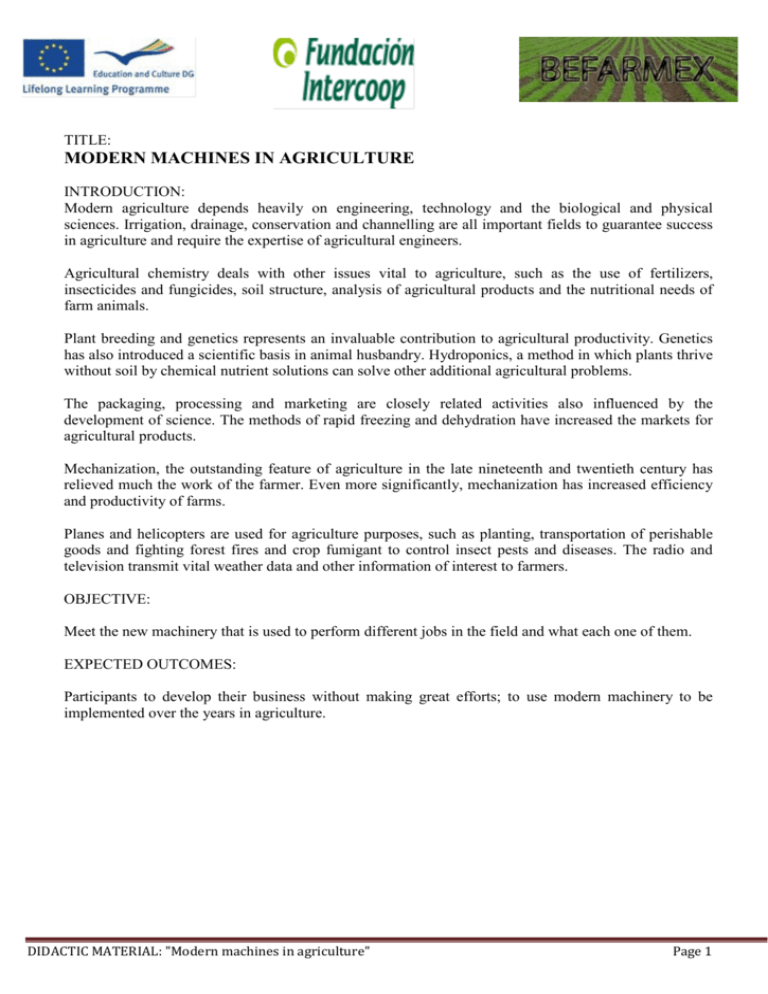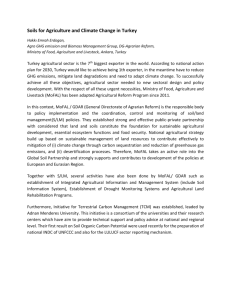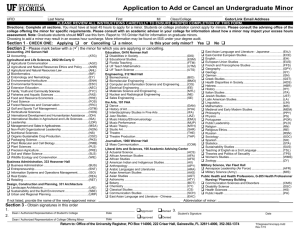modern machines in agriculture
advertisement

TITLE: MODERN MACHINES IN AGRICULTURE INTRODUCTION: Modern agriculture depends heavily on engineering, technology and the biological and physical sciences. Irrigation, drainage, conservation and channelling are all important fields to guarantee success in agriculture and require the expertise of agricultural engineers. Agricultural chemistry deals with other issues vital to agriculture, such as the use of fertilizers, insecticides and fungicides, soil structure, analysis of agricultural products and the nutritional needs of farm animals. Plant breeding and genetics represents an invaluable contribution to agricultural productivity. Genetics has also introduced a scientific basis in animal husbandry. Hydroponics, a method in which plants thrive without soil by chemical nutrient solutions can solve other additional agricultural problems. The packaging, processing and marketing are closely related activities also influenced by the development of science. The methods of rapid freezing and dehydration have increased the markets for agricultural products. Mechanization, the outstanding feature of agriculture in the late nineteenth and twentieth century has relieved much the work of the farmer. Even more significantly, mechanization has increased efficiency and productivity of farms. Planes and helicopters are used for agriculture purposes, such as planting, transportation of perishable goods and fighting forest fires and crop fumigant to control insect pests and diseases. The radio and television transmit vital weather data and other information of interest to farmers. OBJECTIVE: Meet the new machinery that is used to perform different jobs in the field and what each one of them. EXPECTED OUTCOMES: Participants to develop their business without making great efforts; to use modern machinery to be implemented over the years in agriculture. DIDACTIC MATERIAL: "Modern machines in agriculture" Page 1 TRAINING HOURS: The course is a classroom course and lasts for 8 hours. CONTENTS: 1. TYPES OF AGRICULTURE The types of agriculture can be divided according to very different sorting criteria: According to its dependence on water: Dry land farming: Agriculture is produced without the addition of water by the same farmer, feeding the soil from rain and / or groundwater. Irrigation farming: occurs with water intake by the farmer by providing channels that captures natural or artificial surface or by groundwater extraction wells. According to the scale of production and its relation to the market: Subsistence: It consists in producing the minimum amount of food necessary to meet the needs of the farmer and his family, with little surplus to sell. The technical level is primitive. Industrial Agriculture: large quantities are produced using costly means of production and market for surplus. Typical of industrialized countries, the developing countries and the internationalized sector of poorer countries. The technical level is technological. Agriculture can also be defined as market. As seeking maximum performance or minimal use of other means of production, this will determine more or less ecological footprint: Intensive agriculture: looking for a large production in a short space. Leads to increased wear of the site. Typical of industrialized countries. Extensive agriculture: it depends on a larger surface area, i.e., causes less pressure on the place and their ecological relationships, but the business benefits they are minor. According to the method and objectives: Traditional Agriculture: Use of typical systems that have shaped the culture of the same, shorter or longer periods. Industrial Agriculture: based mainly on intensive systems, is focused on producing large quantities of food in less time and space, but more eco-wear, designed to move large commercial benefits. DIDACTIC MATERIAL: "Modern machines in agriculture" Page 2 Organic Farming and Organic Farming: create different production systems that respect the ecological character of sites and geo-biological of the soil, trying to respect the seasons and the natural distributions of plant species. Natural Agriculture. 2. FARM HAND TOOLS Agricultural tools are instruments used to till the land, carrying sand, weeding, soil removal, trenching, carrying fertilizer or materials, etc. They are many and varied agricultural tools, among which are mentioned: Blades: are sheets of metal, preferably steel, used to till the earth can be pointed or so wide, with bottom edge with cutting edge and long wooden handle finished in a metal handle. Peaks: are instruments composed of a steel part whose ends terminate in the form of rectangular blade, on one hand, and land vertically, has a rectangular blade edge and lower edge of wood or metal handle. Hoes: are tools with blade-shaped end; is metal with the lower edge of cutting edge, used to move earth. Machetes: are tools designed to cut, have a long steel blade sharpened, attached to a wooden handle. Rakes: designed to cover or rake seeds have a horizontal portion and formed by metal teeth thin or thick depending on usage. Transplanting tool: small metal blades small spoon-shaped, sharp edges and wooden handle. Serve to remove seeds. Handling: they are small charges that have wheels and are used for loading and unloading agricultural material, whether sand, soil, fertilizers. Bars: steel handles are finished in semi-plant leaf plant and the same metal, medium-length handle. Watering can: are metal containers with water tank with a tube ending in a round room with many small holes, used to water plants. DIDACTIC MATERIAL: "Modern machines in agriculture" Page 3 3. AGRICULTURAL MACHINERY, EQUIPMENT AND TOOLS The machines are elements that are used to direct the action of forces based energy work, for his part in the agricultural, motor mechanisms used in this work lighten the production and improve farming techniques. Among the most widely used agricultural machines working in the fields mentioned: Tractor: is a very useful agricultural machine, with wheels or designed to move easily on the ground and pulling power enabling successful agricultural work, even in flooded fields. It has two brake pedals and is preparing to pull sledges. There are two types of tractors: the track of stability and strength, and wheels, able to travel to by road, has a higher speed than the track. Walking Tractor: agricultural machine is a single axle and is operated by handles, have median motor power and strength led to horticultural and ornamental work, can work in strong fields, but is preferably used in construction of gardens. DIDACTIC MATERIAL: "Modern machines in agriculture" Page 4 Combine: or mower is a powerful engine agricultural machine, comb cutter to cut the plants mature grain and a long rake that goes before the machine and rotates about a horizontal axis. 4. AGRICULTURAL EQUIPMENT Farm equipment is a group of devices designed to open furrows in the ground, shredding, spraying and fertilizing the soil. Plough: agricultural equipment is designed to open furrows in the earth consists of a blade, fence, plough, bead, bed, wheel and handlebar, which serve to cut and level the land, hold parts of the plough, set shot and to serve as handle. There are various types of ploughs but the best known are: mouldboard plough, formed by the grating blade and mouldboard disc plough, disc concave formed by deep grooves to open shallow ploughing to remove the topsoil Subsoil plough to remove the soil depth. DIDACTIC MATERIAL: "Modern machines in agriculture" Page 5 Drag: agricultural equipment is designed to break up the parts and parcels of land that have been removed by the plough, are composed of a frame, which can be made of wood and metal teeth and the latch that attaches to tractor. sprayer: it is a farm equipment designed to spray, is composed of a liquid tank, pressure pump, cap, mouth, tank and pressure valve, belts, hose, faucet and nozzle where the liquid to spray out, is insecticide, fungicide or herbicide. The hand sprayer is placed in the back of the sprayer and this has placed in the mouth and nose a special mask to prevent strong odours dismissed by the substance that expels the sprayer will harm. DIDACTIC MATERIAL: "Modern machines in agriculture" Page 6 Tillage planter: is a machine to place the seeds on the seedbed without prior tillage. Fertilizer: agricultural equipment is designed to distribute fertilizer is composed of three main parts: the hopper or storage of fertilizer, the drop tube of fertilizer and fertilizer distributor. DIDACTIC MATERIAL: "Modern machines in agriculture" Page 7 Packing: agricultural equipment is designed for packaging or packing cereal straw or other baled forage grasses (also called bales or alpacas). METHODOLOGY: The methodology used will be active, participatory, with the use of simulations and case studies to facilitate the subsequent transfer of learning. The method used is inductive, based on knowledge and experience of the attendees. At the same time use focus groups. REFERENCES: For further reference and information please contact: - Intercoop Foundation: tel. 965.92.86.63 email: egarcia@intercoop.es www.intercoop.es - Web: www.aspariegos.com DIDACTIC MATERIAL: "Modern machines in agriculture" Page 8






